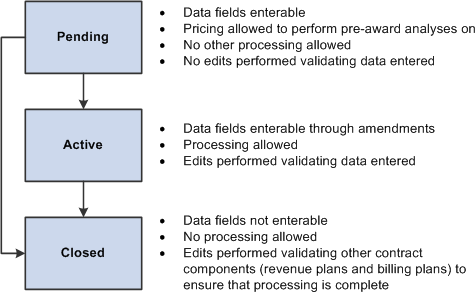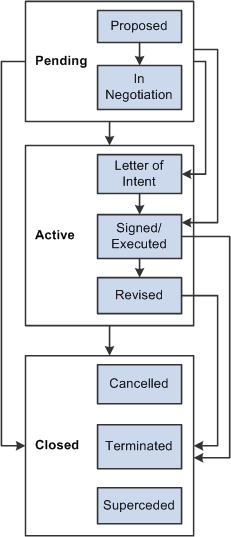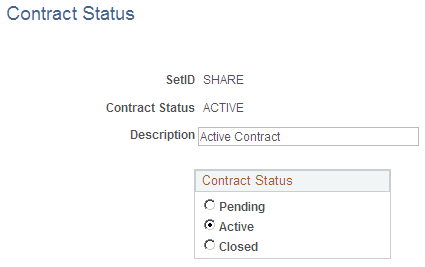Defining Contract Statuses
To define contract statuses, use the Contract Status component (CA_STATUS_PNLG_GBL).
This section provides an overview of contract statuses and discusses how to define contract statuses.
|
Page Name |
Definition Name |
Usage |
|---|---|---|
|
CA_STATUS_PNL |
Define contract statuses and map them to processing statuses. The contract statuses that you define appear in the list of valid values for contract statuses on the Contract - General page. The system uses the contract status to control all processing that can occur against a contract. |
The contract status provides a visual indicator of where your contract is in the contract life cycle, and it designates when a contract is available for lookup and processing. PeopleSoft Contracts delivers a set of system-defined processing statuses that control the type of processing that can occur against a contract. When you set up your PeopleSoft Contracts system, you define a group of contract statuses that apply to your business flow. When you define a contract status, you map it to a system-defined processing status. You can map multiple contract statuses to each system-defined processing status. The contract statuses that you define will appear on the pages throughout your PeopleSoft Contracts system.
Processing Statuses
The processing status is a system-defined value that controls the application processing that can occur against a contract. Every contract that you create in PeopleSoft Contracts is associated with a contract status that is mapped to a processing status of Pending, Active, or Closed. The processing statuses are described here:
Term |
Definition |
|---|---|
Pending |
This is the default processing status when you create a new contract. This status indicates that the contract was created and that some data was entered. Contracts in a status of Pending have these attributes:
|
Term |
Definition |
|---|---|
Active |
This status indicates that all contract data is entered into the system and has passed system data validation. A contract must be in a status of Active for any contract element to be available for application engine processing. Contracts in Active status have these attributes:
Before the processing status for a contract can be set to Active, you must:
|
Closed |
Either the contract was terminated (the status changed from Pending to Closed or was cancelled after execution) or the contract was completed (all contractual obligations were fulfilled and all entitlements were received). Contracts in Closed status are removed from processing and views, but the historical contract data is still available for query. Closed contracts have these attributes:
The system allows you to change the status of a contract from Pending to Closed. However, when you change the status from Pending to Closed or from Active to Closed, the system checks to determine whether any active projects are still associated with the contract. If active projects are associated with the contract, then the system asks whether you still want to close the contract. Before the processing status for a contract can be changed from Active to Closed, these conditions must be met:
|
Status Flow
This diagram shows the flow between the contract header status values and the functionality for each header status value:
The flow between the contract header status values and the functionality for each header status value is displayed

Processing statuses can flow forwards only; that is, you cannot:
Change the status from Active back to Pending.
Change the status from Closed back to Active.
Change the status from Closed back to Pending.
When you initiate a change in the processing status for a contract, the system performs a series of checks to ensure that the contract meets all necessary criteria to move to the next processing status level. Unless the contract meets all necessary criteria, the processing status cannot advance.
Company-Specific Contract Statuses
You can define contract statuses that are applicable to your company's business environment. These contract statuses, which appear in the Status field of the Contract - General page, indicate where a contract is in its contract life cycle. When you define a contract status, you map that status to one of the three processing statuses described previously. The system then uses the mapped processing status to control processing activity for a contract.
You might want to define these contract status types:
Term |
Definition |
|---|---|
Proposed |
Contract is drafted and in the customer's hands. |
In Negotiation |
Contract was reviewed and returned by the customer; additional negotiations are in progress. |
Letter of Intent |
You and the customer reached an initial agreement relating to the scope of work or billing terms, and the contract is now being processed for execution (for example, it's going through legal review). |
Signed/Executed |
Contract was finalized and signed by both parties. |
Approved |
Contract was signed, entered into the PeopleSoft Contracts system by the contract administrator, and approved within the PeopleSoft Contracts system by management or by the authorized review organization. |
Revised/Expanded |
Signed contract was revised or terms and contract lines were added. |
Cancelled/Reversed |
Signed contract was reversed as if it never existed. |
Terminated |
Signed contract was interrupted in the middle of the original obligations. |
Superseded |
Signed contract was replaced by another signed contract. |
This table provides examples of how you might map the contract status types described previously to processing statuses:
|
User-Defined Contract Status Type |
Processing Status Example 1 |
Processing Status Example 2 |
Processing Status Example 3 |
|---|---|---|---|
|
Proposed |
Active |
Pending |
Pending |
|
In Negotiation |
Active |
Pending |
Pending |
|
Letter of Intent |
Active |
Active |
Pending |
|
Signed/Executed |
Active |
Active |
Pending |
|
Approved |
Active |
Active |
Active |
|
Revised/Expanded |
Active |
Active |
Active |
|
Cancelled/Reversed |
Closed |
Closed |
Closed |
|
Terminated |
Closed |
Closed |
Closed |
|
Superseded |
Closed |
Closed |
Closed |
The system does not enforce a contract status hierarchy for contract statuses that are mapped to the same processing status. For example, in Processing Status Example 2 from the previous table, the system does not always force a user to move the contract status from Proposed to In Negotiation to Letter of Intent.
This diagram shows the contract status setup for a user who allows processing anytime after a letter of intent is signed. However, this user does not require that the contract always go from Proposed or In Negotiation to Letter of Intent.
The contract status setup for a user who allows processing anytime after a letter of intent is signed is shown.

Optionally, you can enable status security for a PeopleSoft Contracts business unit by selecting the Enforce Contract Status Security check box on the Contracts Definition - BU Definition page. When status security is enabled, only those users to whom you assigned permission for a status can manage that contract status.
Use the Contract Status page (CA_STATUS_PNL) to define contract statuses and map them to processing statuses.
The contract statuses that you define appear in the list of valid values for contract statuses on the Contract - General page. The system uses the contract status to control all processing that can occur against a contract.
Navigation:
This example illustrates the fields and controls on the Contract Status page. You can find definitions for the fields and controls later on this page.

Select the processing status to which this contract status should be mapped.
Warning! Once you define a contract status and use it on a contract, do not remap that contract status to a different processing status. Doing so will cause a change in processing status for any contracts that are mapped to that contract status.
Field or Control |
Description |
|---|---|
Default |
Select to make this contract status the default status for all new contracts that you create. A contract status must be mapped to a processing status of Pending to be designated as the default status. This field appears only when you create a new contract status. |